
About UsThe Numismatic Bibliomania Society is a non-profit organization promoting numismatic literature. For more information please see our web site at coinbooks.org SubscriptionsThose wishing to become new E-Sylum subscribers (or wishing to Unsubscribe) can go to the following web page link MembershipThere is a membership application available on the web site Membership Application To join, print the application and return it with your check to the address printed on the application. Membership is only $15 to addresses in the U.S., $20 for First Class mail, and $25 elsewhere. For those without web access, write to: David M. Sundman, Secretary/TreasurerNumismatic Bibliomania
Society AsylumFor Asylum mailing address changes and other membership questions, contact David at this email address: dsundman@LittletonCoin.com SubmissionsTo submit items for publication in The E-Sylum, just Reply to this message, or write to the Editor at this address: whomren@coinlibrary.com
BUY THE BOOK BEFORE THE COINYou won't regret it! |
- WAYNE'S WORDS: THE E-SYLUM AUGUST 19, 2012
- MORE ON THE 2012 PHILADELPHIA CONVENTION NBS MEETINGS
- COMMENTS ON E-SYLUM NLG AWARD FOR BEST TRADE WEB SITE
- LAKE BOOKS 112TH MAIL-BID SALE CATALOG AVAILABLE
- KOLBE & FANNING OFFER ADMIRAL VERNON BOOK AND MEDAL DEAL
- KOLBE & FANNING’S 2012 AFTER-ANA SALE
- NEW BOOK: DE KONGELIGE MØNTSTEDER I ALTONA OG KØBENHAVN 1813-1873
- NEW BOOK: FOLLOW THE MONEY: A MONTH IN THE LIFE OF A TEN-DOLLAR BILL
- NEW BOOK: NUMISMATIC GLEANINGS
- NEW BOOK: ANGLO-SAXON COUNTERFEITS:, A.D. 600-1066
- THE SS CENTRAL AMERICA TREASURE AND THE HUNT FOR TOMMY THOMPSON
- E-SYLUM READERS REMEMBER VINCENT ALONES
- NOTES FROM E-SYLUM READERS: AUGUST 19, 2012
- GEORGE CLAPP'S COST CODE: MENDACIOUS
- 19TH CENTURY COUNTERFEIT DETECTION & PREVENTION LITERATURE
- QUERY: THE LOST ARCHIVES OF AUGUSTUS HEATON SOUGHT
- ERIC NEWMAN: A NATIONAL TREASURE
- ARTICLE HIGHLIGHTS BANKNOTE EXPERT BARNABY FAULL OF SPINK
- WAYNE'S NUMISMATIC DIARY: AUGUST 19, 2012
- ABE KOSOFF INDUCTED INTO THE DEALERS HALL OF FAME
- QUERY: WORLD WAR I VERDUN MEDAL INFORMATION SOUGHT
- MONTFORD POINT MARINES AWARDED CONGRESSIONAL GOLD MEDAL
- CHIANG KAI-SHEK'S ORDER OF BLUE SKY AND WHITE SUN MEDAL
- NEW MEDAL REPOSITORY OPENED IN WAIOURU, NEW ZEALAND
- BANK OF CANADA PURGED IMAGE OF 'ASIAN-LOOKING' WOMAN
- THE LITHUANIAN BANK NOTE BUILDING
- FEATURED WEB PAGE: LITHUANIAN-AMERICAN LODGE TOKENS
WAYNE'S WORDS: THE E-SYLUM AUGUST 19, 2012

New subscribers this week include Clyde Takahashi of Kahului, Hawaii and Steve Bishop of Manassas Park, VA. Welcome aboard! We have 1,586 email subscribers, plus 188 followers on Facebook.
This week we open with more reports on the NBS meetings at last week's ANA convention, a follow-up on The E-Sylum's 2012 NLG award, and notes from numismatic literature dealers Fred Lake and Kolbe & Fanning. As if that's not enough, we have information on FOUR new numismatic (or related) titles.
Other topics include the S.S. Central America treasure, George Clapp's cost code, the Long Island Coin Club and their Grand Central Coin Conventions, Abe Kosoff, Eric Newman, and Harvey Elfenstein.
To learn more about 19th Century Counterfeit Detection & Prevention Literature, Rufus Tyler's letter to Alexander Bache, loving your numismatic librarian, Augustus Heaton, "To Gus For Valor", Lithuanian American lodge tokens and the tokens of Nuttsville, VA, read on. Have a great week, everyone!
Wayne Homren
Editor, The E-Sylum
MORE ON THE 2012 PHILADELPHIA CONVENTION NBS MEETINGS
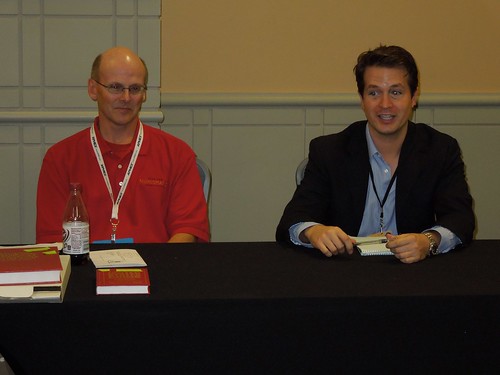
Kerry Wetterstom and Steve Roach
NBS Numismatic Literature Symposium Philadelphia August 2012
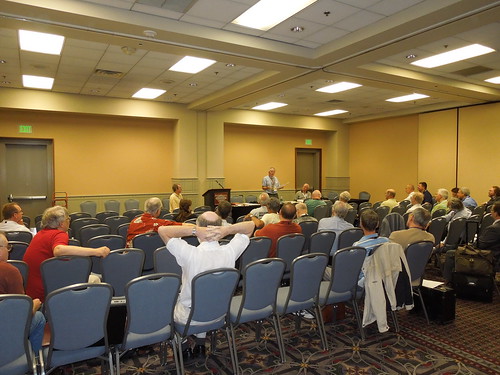
NBS General Meeting Philadelphia August 2012
For a slide show of all photos, see: www.flickr.com/photos/coinbooks/sets/72157631119031968/show/
American Numismatic Society Librarian Elizabeth Hahn writes:
I'm going to be working on an article for the next Asylum that will give more detail about the NBS Symposium (specifically with the idea that such a write-up could benefit those who were unable to attend, along with my own comments). Another reason for E-Sylum readers to join the NBS, since the article will only appear in the print copy of the Asylum for members! I can say here though that both the symposium and the general meeting presentations were very interesting and there was a great deal of interest generated among those in attendance, as evidenced by the many questions for the speakers.
I did want to make a quick note about something that came up in the discussion at the NBS general meeting. There were questions about the indexing of The Celator and Coin World and copies made available digitally. I thought it would be useful to mention once again that the ANS Library has actively indexed numerous numismatic periodicals, including The Celator and Coin World, and as such the online library catalog, DONUM, is an excellent tool for researchers wishing to browse items in those journals (and more).
We have more than 1,400 article records from The Celator in DONUM and more than 6,000 from Coin World! These go all the way back to the early issues from the 1960s as well. If anyone has questions about this or how to best utilize searching the catalog, please contact me at the ANS Library.
Scott Barman writes:
NBS events went well at last week's ANA convention in Philadelphia. On Thursday, about 40 people attended the symposium which was a panel discussion about "Auction Catalogs from Various Perspectives" with Kerry Wetterstrom of The Celator and Steve Roach of Coin World.
I attended part of the NBS event on Thursday at the World's Fair of Money. I am sorry I missed the first half of the meeting and the meeting the next day as I was working for part of this show. However, during the question and answer period there was a discussion on electronic publications and the issue with archiving them for long periods of time. There were good points made for paper versus electronic, but it is a subject that should be a part of NBS's agenda now and in the future as a lot of NBS.
For those who attended the seminar, I am the one who has the computer-related background who has some background knowledge of the National Archives and Records Administration's (NARA) requirements for collecting and maintaining digital records. Part of my work is to help the agencies I have worked with to build systems to support long term record retention based on NARA guidelines.
As soon as I send my check to David Sundman (I was sitting behind David at the seminar), I will be an NBS member and would like the opportunity to participate in future discussions regarding digital archiving of numismatic materials. For the moment, I have a real paper book I bought from David Fanning that I am interested in reading, especially since I have not seen it in electronic form.
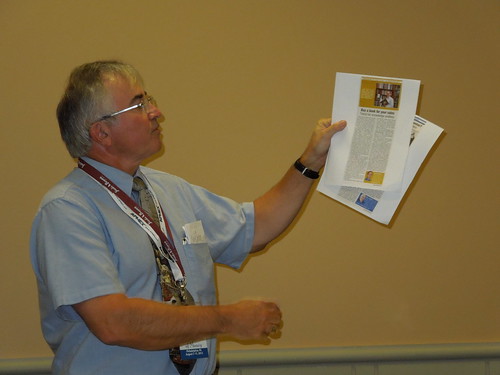
David Sundman
Regarding the fundraising auction, George Kolbe writes:
As mentioned at the NBS meeting, some months ago Kolbe & Fanning came into possession of a large paper copy of the recent award-winning Joel Orosz and Len Augsburger book on the Secret History of the U.S. Mint. It is believed to be unique, and it is also an error copy. It may possibly be the only large paper copy of a numismatic work produced in the twenty-first century. Given its many special attributes (one would want to read a regular size copy anyway, given the heft), Kolbe & Fanning expect that it will be looked upon in the future as a missed opportunity by the several underbidders.
Dan Freidus writes:
George is being a bit cryptic. The error he's referring to (or, at least, the one I noticed) is that while the book is a gorgeous huge (I'd guess about 11"x15") hardbound copy of the book with the cover illustration of the original enlarged to fit the oversize binding, the interior pages all seem to be blank, making the history of the U.S. Mint even more secret in this unique copy!
Joel Orosz writes:
There are those who would say that this blank version is the best edition of the book!
What a hoot this is--and it allows me to taunt all other numismatic authors--even Dr. Maris--by saying "mine's bigger than yours!"
Picking up on Joel's expression, George Kolbe writes:
Yes, it is a Humongously Oversize Orotund Tome.
Joel responds:
I simply cannot top George's acronym--it's...well, it's a HOOT!
Dan Hamelberg writes:
Thanks for the magnificent buildup of the large paper copy of Joel and Len's BLANK BOOK on the U.S. Mint. As the proud winner of the BLANK BOOK from the recent NBS auction, I must say that all the superb accolades attributed to the Large Paper copy will most surely enhance its future status and value in the world of Numismatic Literature. I can't thank you enough.
Joel wraps up with:
It took more than a century, but at last we can say that The Coins of New Jersey is no longer the biggest book in numismatics. Dr. Edward Maris, eat your heart out! Congratulations, Dan--what a cool book to own!
That wasn't the only fun bit of hokum at the meeting. Joel Orosz writes:
Dennis Tucker donated a beautifully bound book entitled The Sketchbook and Notes of Lincoln Vanderblatt. According to Dennis's tongue-in-cheek description, Lincoln Vanderblatt is the grandson of the celebrated Archibald Vanderblatt, author of the 1911 classic numismatic reference, Good Manners for Today's Polite Coin Collector.
Lincoln's Sketchbook contains original poetry, sketches and other musings upon all manner of topics numismatic, as can be seen from the accompanying photos. The one-of-a-kind Sketchbook was the star of the NBS benefit auction, realizing $1,100 after heavy bidding competition, and clearly worth every penny!
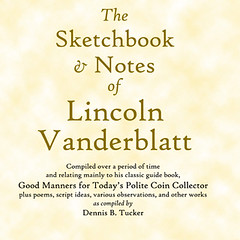
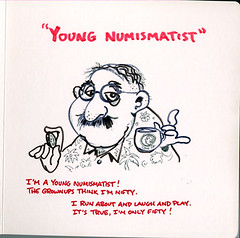
To read the earlier E-Sylum article, see: REPORT ON THE 2012 PHILADELPHIA CONVENTION NBS MEETINGS (www.coinbooks.org/esylum_v15n34a02.html)
COMMENTS ON E-SYLUM NLG AWARD FOR BEST TRADE WEB SITE
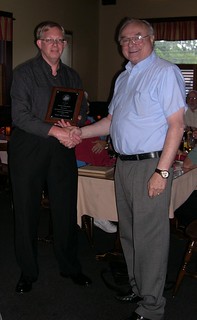 On Tuesday at the meeting of Nummis Nova Howard Daniel recruited NLG member Joe Levine to present me with the 2012 NLG award for the Best Trade Press Web Site. Howard captured the event with a photo - that's me on the left and Joe on the right. Thanks!
On Tuesday at the meeting of Nummis Nova Howard Daniel recruited NLG member Joe Levine to present me with the 2012 NLG award for the Best Trade Press Web Site. Howard captured the event with a photo - that's me on the left and Joe on the right. Thanks!
Many thanks to E-Sylum readers who expressed their congratulations, including Joel Orosz, Jim Duncan, Bob Stark, Ken Berger, Bruce Perdue, Pete Smith, Kerry Rodgers and several others.
The web address, of course, is
www.coinbooks.org/esylum/
.
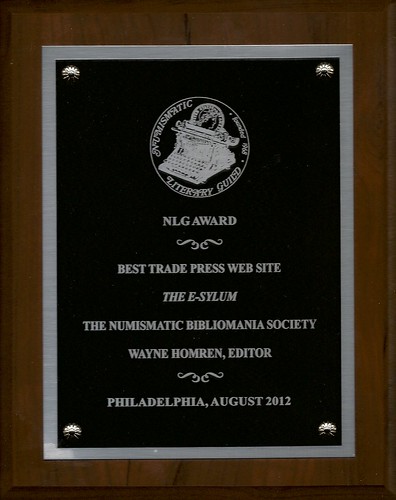
To read the complete article, see: E-SYLUM WINS NLG AWARD FOR BEST TRADE WEB SITE (www.coinbooks.org/esylum_v15n34a03.html)
LAKE BOOKS 112TH MAIL-BID SALE CATALOG AVAILABLE
Lake Books announces that its 112th mail-bid sale of numismatic literature is now available for viewing on our web site at www.lakebooks.com/current.html The 470-lot sale features selections from the libraries of David E. Litrenta and George J. Fuld. You will find works on United States coinage, Ancient and World Coin books, Paper Money references, and some especially desirable material covering the field of Tokens and Medals.
The sale closes on Tuesday, September 11, 2012 at 5:00 PM (EDT) and your bids may be placed via email, standard US Mail, telephone or fax (please note again our new fax number 727-381-6822).
Good Luck with your bidding, Fred
Lake Books
6822 22nd Ave. N.
St. Petersburg, FL 33710
727-343-8055 Fax 727-381-6822
Fred adds:
Our printed catalog was mailed on Tuesday, August 14, 2012 and the following corrections should be noted in both the printed and the (just recently) corrected electronic versions.
Lots C 23, C 96, and H 15 do not exist and should be deleted from your copy.
Also, lot C 92, the Dr. Glenn Peterson book on "Attributing Bust Half Dollars" is in reality hardbound in green cloth.
Hopefully these will be the last of our errors that we noticed.
KOLBE & FANNING OFFER ADMIRAL VERNON BOOK AND MEDAL DEAL
 At the risk of upsetting Aaron Feldman’s dictum to “buy the book before the coin,” Kolbe & Fanning Numismatic Booksellers are making a limited-time offer. While supplies last, anyone ordering a copy of Medallic Portraits of Admiral Vernon: Medals Sometimes Lie, by John W. Adams, Fernando Chao and Anne E. Bentley, will receive an actual Admiral Vernon medal from the supply of duplicates in the Adams collection at no additional cost. Each medal will be in attributable condition.
At the risk of upsetting Aaron Feldman’s dictum to “buy the book before the coin,” Kolbe & Fanning Numismatic Booksellers are making a limited-time offer. While supplies last, anyone ordering a copy of Medallic Portraits of Admiral Vernon: Medals Sometimes Lie, by John W. Adams, Fernando Chao and Anne E. Bentley, will receive an actual Admiral Vernon medal from the supply of duplicates in the Adams collection at no additional cost. Each medal will be in attributable condition.
The book, with an attributable medal to accompany it, is $95 plus $5 shipping in the U.S. Please contact Kolbe & fanning for information on shipping outside the U.S.
To order, please contact David Fanning at df@numislit.com or at (614) 441-0855. Kolbe & Fanning’s offices are at 141 W. Johnstown Rd., Gahanna, OH 43230.
KOLBE & FANNING’S 2012 AFTER-ANA SALE
Kolbe & Fanning Numismatic Booksellers have returned from the recent American Numismatic Association show with books on ancient, foreign and U.S. numismatics. We are holding a week-long sale of these items, which are available on the Kolbe & Fanning website at www.numislit.com. Go to “After-ANA Sale” and view the online listing. Customers may purchase items from the list for 10% off through Wednesday, August 22, at which time the list will be removed and the sale ended.
The online listing is a simple checklist, with admittedly minimal information: please contact us for more information on any items you might be interested in.
Please note that the sale was first announced on the Kolbe & Fanning Facebook page and was publicized the following day via our email list. To find us on Facebook, simply search for Kolbe & Fanning Numismatic Booksellers. The join our email list, please send an email to David Fanning at df@numislit.com.
NEW BOOK: DE KONGELIGE MØNTSTEDER I ALTONA OG KØBENHAVN 1813-1873
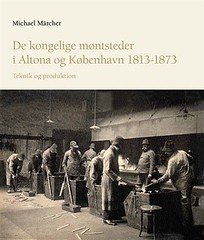 Most of the world’s mints underwent important changes in the 19th century as a consequence of the significant economic, political and technical development. Though mints were key works in societies with monetary systems based on precious metals, the mints in the realm of the Danish king have so far not been the subject of exhaustive historical studies.
Most of the world’s mints underwent important changes in the 19th century as a consequence of the significant economic, political and technical development. Though mints were key works in societies with monetary systems based on precious metals, the mints in the realm of the Danish king have so far not been the subject of exhaustive historical studies.
This thesis is a study of the mints in Altona near Hamburg and Copenhagen circa 1813-73; it is based primarily on the extensive written source material generated by the two state-owned coin producing facilities.
The introduction with presentation of source material, method and theory is followed by the thesis’ three main chapters, which focus on 1) tasks and organization, 2) technique, and 3) production.
The settings for the mints’ activities are studied in the first chapter. The primary task was coin production for the state, while the secondary tasks were other operations for the state and coin production for private customers. Each mint was characterised by a hierarchical structure and control with approximately 10-12 specialised employees and a varying number of day-labourers.
The second chapter is a study of the mints’ physical settings, energy sources and production stages in an international perspective with focus on technique. It shows a significant change in the minting technique; new machines and/or methods replaced old techniques, which meant widespread mechanisation and important qualitative and quantitative improvements.
The new minting techniques were imported primarily from England and Germany, especially after study tours. The Copenhagen mint was among the most advanced works in Denmark, and both mints’ technique was internationally prominent in the first third of the century. Denmark was in that period one of the few countries in which all mints produced the new modern coins that still dominate today.
The coinage and the mints’ role in the monetary policy are the basis for the third chapter’s study of the production. It shows that the period was dominated by a) tasks for the state, e.g. monetary counselling, but especially the state’s attempt to create a common, homogeneous monetary system in the kingdom and the duchies, b) extensive coin production for private customers from the 1820’s to the 1850-60’s, and c) cooperation with the National Bank, which undertook important coin production and came to play an increasingly important role for the mints.
The changing economic and political conditions and the state’s demands presented different challenges and an uneven development of the mints, e.g. the Altona mint was closed down in 1863. This development and the decline in private customers in the 1850-60’s, the National Bank’s increasing role and the mechanisation of the production led to modernisation of the mints and their production in the 19th century.
ISBN: 978-87-7674-637-7
Price c. 53 EUROs.
350 pages.
more than 300 illustrations, many regarding minting techniques/coin production/mints
Large format, 25x28 cm.
For more information, or to order, see: De kongelige møntsteder i Altona og København 1813-1873 (www.universitypress.dk/shop/de-kongelige-moentsteder-3162p.html)
NEW BOOK: FOLLOW THE MONEY: A MONTH IN THE LIFE OF A TEN-DOLLAR BILL
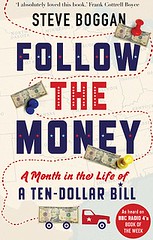 When author Steve Boggan decided to fulfill a life-long ambition to follow a ten-dollar bill across the U.S, it took him on an epic and inspiring journey. Here, he tells his incredible story which has now inspired a book.
When author Steve Boggan decided to fulfill a life-long ambition to follow a ten-dollar bill across the U.S, it took him on an epic and inspiring journey. Here, he tells his incredible story which has now inspired a book.
Two days ago, I was in Kansas, yesterday it was Somewhere-ville, Missouri, so today … it must be Hot Springs, Arkansas, the place where Bill Clinton grew up.
Not for the first time in the past few days, I ask myself: ‘What on earth am I doing?’
Welcome to a typical morning during the weirdest and most wonderful time of my life, 30 days and nights when I fulfilled an ambition that had been gnawing away at me for years: to follow a ten-dollar bill across the United States of America for a whole month.
Bonkers, I know. Pointless, possibly. Chaotic, definitely. But it took me on an epic journey into the heart of an America I never knew existed.
 I gave away the bill – serial number IA74407937A – and followed as it wheeled across the Great Plains and fizzed through bustling cities, passing from person to person in a great human relay across 3,300 miles, through Kansas, Missouri, Arkansas, Illinois, Indiana and, finally, Michigan.
I gave away the bill – serial number IA74407937A – and followed as it wheeled across the Great Plains and fizzed through bustling cities, passing from person to person in a great human relay across 3,300 miles, through Kansas, Missouri, Arkansas, Illinois, Indiana and, finally, Michigan.
On the way, it introduced me to farmers, truckers, musicians, missionaries, bankers, nurses, army veterans, bartenders, car workers, deer hunters and many others, people who took me into their lives, fed me and gave me a bed for the night.
They made me welcome and demonstrated levels of kindness that left me humbled. They made me laugh and cry, got me drunk on booze and excitement, and held on to me for longer than was entirely necessary out of sheer generosity.
And they did all this because of a piece of paper bearing the image of Alexander Hamilton, the first U.S. Secretary of the Treasury, and the pity they felt towards the dishevelled, shambolic and rather confused Englishman who was following it.
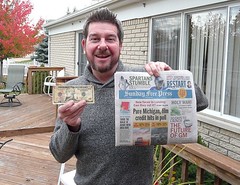 I had travelled through the U.S. many times before, but always on assignment, always rushing from place to place on interstate highways, and it was not until the bill took me off the main highways and byways that I discovered the true America.
I had travelled through the U.S. many times before, but always on assignment, always rushing from place to place on interstate highways, and it was not until the bill took me off the main highways and byways that I discovered the true America.
Our opinions of the States are informed by Hollywood and American foreign policy – a policy that often drags us reluctantly into conflict. But many Americans do not see themselves in these images.
Instead, I found a warmth and friendship I neither expected nor deserved – a coincidence you might say over one or two hundred miles, but across 3,300, something that could not be put down to chance.
To read the complete article, see:
How I followed a banknote 3,500 miles across America: British author turns adventures of a $10 bill into a book
(www.dailymail.co.uk/news/article-2188308/Passing-bucks-British
-authors-3-500-mile-epic-journey-U-S-pursuit-10-bill.html)
NEW BOOK: NUMISMATIC GLEANINGS
 The present work contains thirty-three articles of the authors on some unique, interesting and significant coins and sigils which throw flashes of light on various aspects of the history, culture, religion, art, economy, trade and commerce, science and technology of the people of India in different periods of its long history. It is for the first time that minuscule copper punch-marked coins from Vidisha have been brought to light which acquaint us of the local economy during the later half of the first millennium BCE. The uniface cast copper coins collected from eastern Malwa and Khandesh region establish relationship of the area with the Deccan which has yielded similar coins.
The present work contains thirty-three articles of the authors on some unique, interesting and significant coins and sigils which throw flashes of light on various aspects of the history, culture, religion, art, economy, trade and commerce, science and technology of the people of India in different periods of its long history. It is for the first time that minuscule copper punch-marked coins from Vidisha have been brought to light which acquaint us of the local economy during the later half of the first millennium BCE. The uniface cast copper coins collected from eastern Malwa and Khandesh region establish relationship of the area with the Deccan which has yielded similar coins.
Coins of the city-state of Hathodaka indicate the role the city-states played in the development of trade and commerce in the Narmada valley during the early centuries before the commencement of the Common Era. The silver and copper coins from Eran-Ujjayini region indicate the continued use of the white metal and corroborate the popularity of Vaishnavism in central India evidenced earlier by the discovery of an elliptical temple plan and the Garuda-dhvaja pillar inscription at Vidisha. The indigenous gold coin confirms the use of this valuable metal for indigenous coinage before the Kushanas.
Authors (s): Devendra Handa (Author) , Dr. Major M.K. Gupta (Author)
Format: Hardcover
ISBN-13: 9788173201257
Pages: 244p., B/W Illustrations; 26cm.
Pub. date: 09.08.2012, 1st ed.
Publisher: Agam Kala Prakashan
Language (s): English
Bagchee ID: BB73672
List price: US $ 109,00
Bagchee price: US $ 98,10
For more information or to order, see: Numismatic Gleanings (www.bagchee.com/books/BB73672/numismatic-gleanings)
NEW BOOK: ANGLO-SAXON COUNTERFEITS:, A.D. 600-1066
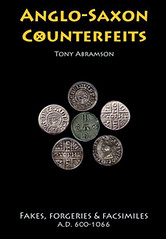 Tony Abramson, Anglo-Saxon Counterfeits: Fakes, Forgeries and Facsimiles, A.D. 600-1066, 207 pp., 2012. GBP 29.99 (p/b) + P&P GBP 6.90.
Tony Abramson, Anglo-Saxon Counterfeits: Fakes, Forgeries and Facsimiles, A.D. 600-1066, 207 pp., 2012. GBP 29.99 (p/b) + P&P GBP 6.90.
Around 1280, speaking of currency crimes, specifically clipping, a leading European theologian exclaimed: “Cut off their hands! How much blood has been spilled by these and others like them who invalidate the currency. These are the ones that have brought destruction … If our combined influence is great enough let them be publicly flogged!”
Whilst this sentiment might nowadays be reserved for currency and commodity speculators, derivative traders and associated casino bankers, the topic of this book is more narrowly defined as exposing the crime of those whose interests are not in disrupting global trade in current commodities but in despoiling the legitimate exchange and assemblage of historical artefacts at an individual level. Both remain the pernicious, cynical spivvery of a mean-spirited, selfish individual; only the scale of operation differs.
As long as civilisation has used coins as a form of currency there have always been individuals who, for a number of reasons, have made fakes, replicas and counterfeits. Not all counterfeits are produced for personal profit and not all replicas are designed to deceive. However, to both the scholar and collector, historical counterfeits have long been a matter of serious interest and concern and, in certain circumstances, an area of study in their own right.
The Anglo-Saxon coinage, with its huge variety of designs and styles, has always been an attractive subject for the makers of counterfeits. From the contemporary craftsmen who produced their own derivative copies to supplement the limited supply of coins, to the modern makers of museum replicas, the coins of the Anglo-Saxon period have been copied, replicated and forged to produce a corpus of material almost as extensive as the originals from which they draw their inspiration.
In this groundbreaking new study Tony Abramson brings together a vast catalogue of Anglo-Saxon counterfeits and copies. Fully illustrated with over 3,000 detailed images this study examines the types, styles and creative inspirations that have fascinated and intrigued all those who study early coinage for generations. From contemporary copies to modern fakes, the catalogue is an essential guide for both scholars and collectors.
The book was presented at the York Stamp and Coin Fair. In addition visitors could provide themselves with a copy of the fourth volume of The Yorkshire Numismatist containing many intriguing articles on Anglo-Saxon numismatics, hoards and much more. The volume is available at £25 + £6.90 P&P (Great Britain). For more information visit the website of The Yorkshire Numismatic Society (yorkshirenumismatic.blogspot.de/.
To read the complete article, see: Book on Anglo-Saxon counterfeits (www.coinsweekly.com/en/News/4?&id=1398)
THE BOOK BAZARRE
THE SS CENTRAL AMERICA TREASURE AND THE HUNT FOR TOMMY THOMPSON
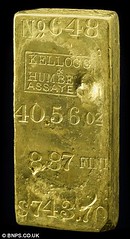 A gold bar recovered from a ship that sank during the Californian Gold Rush is up for auction - with an estimate set at 211 times it's original value.
A gold bar recovered from a ship that sank during the Californian Gold Rush is up for auction - with an estimate set at 211 times it's original value.
The ingot, which weighs 40oz and is expected to sell for about $140,000, was part of a 10-ton hoard of gold that went down with the SS Central America in 1857.
At the time, the cargo was worth $2million and its loss during a hurricane contributed to the ‘Panic of 1857’ - the world’s first world-wide economic crisis. In 1987 much of the hoard was recovered from the seabed after the so-called ‘Ship of Gold’ was discovered in the Atlantic.
The epic discovery sparked a nine year legal battle after a host of insurance companies that paid out for the loss 155 years ago claimed ownership. But it was ruled that 92 per cent of the bullion should be awarded to the discovery team, led by Tommy Thompson, whose company Columbus-America Discovery Group found the ship.
Now this Kellog and Humbert ingot from the ship is to be sold at auction.
To read the complete article, see:
Ingot recovered from 'Ship of Gold' which sank off the U.S. in 1857 expected to sell for $140,000 - 211 TIMES its original value
(www.dailymail.co.uk/news/article-2188162/Ingot-recovered-Ship-Gold
-sank-U-S-1857-expected-sell-100-000--211-TIMES-original-value.html)
An Ohio judge has ordered the arrest of a man in legal trouble over ownership of shipwrecked gold from the 1850s.
The Columbus Dispatch reports that U.S. District Judge Edmund Sargus Jr. issued an arrest warrant Monday for Tommy Thompson after he failed to appear in court for charges linked to a lawsuit by seamen.
They claim they are entitled to some treasure from the S.S. Central America. The ship sank in 1857 and was located by Thompson and his crew in the 1980s.
Sargus recently ordered Thompson to disclose the whereabouts of 500 gold coins and money from a trust. Thompson has said the trust money is gone and the coins are in a trust in Belize.
To read the complete article, see:
Judge orders arrest in dispute over shipwrecked gold
(www.ohio.com/news/break-news/judge-orders-arrest-in-dispute
-over-shipwrecked-gold-1.327045)
Where is reclusive shipwreck salvager Tommy Thompson?
U.S. marshals were told yesterday to hunt down the former Battelle engineer, arrest him and bring him to federal court in Columbus.
Thompson, 60, did not show up at a contempt-of-court hearing yesterday. That prompted U.S. District Judge Edmund A. Sargus Jr. to issue the arrest order.
“Today is the day of reckoning for him,” Sargus said.
Thompson has a history of ducking court appearances, Sargus said. Despite being the major defendant in a 6-year-old lawsuit in Sargus’ court, Thompson never has appeared before the judge.
The lawsuit was filed by seamen who worked for Thompson in the late 1980s when he headed an expedition to find the SS Central America, a steamer that sank along the East Coast in 1857 with tons of gold in its hold. Thompson and his company, Columbus America Discovery Group, brought up part of the treasure and were engulfed in lawsuits over its ownership.
To read the complete article, see:
Salvager’s arrest ordered by judge
(www.dispatch.com/content/stories/local/2012/08/14/salvagers-arrest
-ordered-by-judge.html)
E-SYLUM READERS REMEMBER VINCENT ALONES
Regarding Vincent Alones, David T. Alexander writes:
Vinnie was an early guiding spirit to the Lithuanian Numismatic Association (LNA), founded in the 1970s. Here was a specialty club whose newsletter published a seemingly endless wealth of information on the rich numismatic heritage of this small Baltic nation. With the enthusiastic participation of the irrepressible Frank Passic of Albion, Michigan, LNA's newsletter The Knight became a treasure trove of vital information and a file of the publication is a resource of the greatest value to those fortunate enough to possess it. He will be missed.
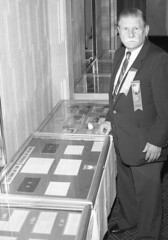 My Vinnie memories are associated with the Long Island Coin Club and their Grand Central Coin Conventions held at the New York Sheraton on 53rd and 7th. Also his involvement with G.E.N.A. and ANA exhibiting.
My Vinnie memories are associated with the Long Island Coin Club and their Grand Central Coin Conventions held at the New York Sheraton on 53rd and 7th. Also his involvement with G.E.N.A. and ANA exhibiting.
The LICC - really started YN meetings about two years before Florence Shook came onto the scene to use their successful model of youth run programs to make them, errr, her-own, and of course to re-write history.
Vinnie loved jokes, and with his fellow LICC coin club committee members, he heard many, however he was awful at remembering them. Thus he often became the butt of another joke.
Vinnie and Aggie were a team, and would clear the dance floor when a polka was played at the holiday dinners. They both enjoyed their Lithuanian heritage.
The Long Island Coin Club tolerated YNs at the convention, to help set-up and break town and pack away cases, to attend meetings and dinners, but they would not allow them to join the club until they were 21. Vinnie helped start a Holliswood Coin Club for YNs which lasted a few years.

1986 Grand Central
Richard Margolis, Donald Partrick, Vincent Alones, and John J. Ford
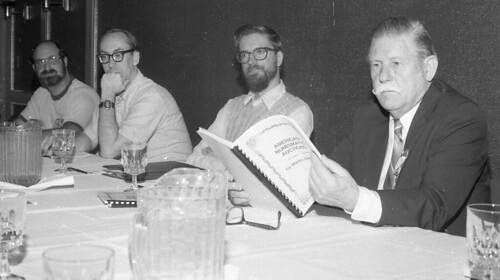
undated Grand Central show
Three mystery gentlemen and Vincent Alones
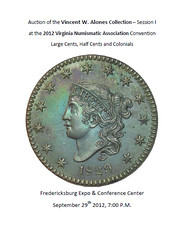 The Virginia Numismatic Association will host an auction of the Vincent Alones Collection which includes Colonials, Half Cents and Large Cents on September 29th, 2012 at 7:00 PM. Catalogs are available on-line including mail-in bidder sheets at:
vnaonline.org/images/Alones-Catalog-for-VNA.pdf .
The Virginia Numismatic Association will host an auction of the Vincent Alones Collection which includes Colonials, Half Cents and Large Cents on September 29th, 2012 at 7:00 PM. Catalogs are available on-line including mail-in bidder sheets at:
vnaonline.org/images/Alones-Catalog-for-VNA.pdf .
Mail bids are being accepted now. Hundreds of additional coins from the collection will be offered at fixed prices at the Virginia Numismatic Association, 54th Annual Convention and Coin Show at the Fredericksburg Expo and Conference Center on the bourse floor. About three hundred coins will be available only seen in person at the show. Preview auction lots until 4:30 PM the day of the auction at the bourse tables of Apoth Coins of Lynchburg, Virginia.
Many of the coins come with original auction flips annotated with prices paid to dealers such as Abe Kosoff, B. Max Mehl, Stacks, New Netherlands Coin Company, Macy’s Department Store and with provenance to Anderson DuPont, Farish Baldenhofer, Richard Picker, the 1973 Pine Tree Auction and many others.
As a boy, Vincent Alones searched his change in the 1920s and 1930s looking for (and finding) 1914-Ds and 1909-S Lincoln cents that could be sold for more than face value or traded for Large Cents. By 1934 he accumulated about twenty dollars in large cents, and decided to start collecting the series over again looking for high grade examples, obtained from coin shops and auction houses in New York from which he acquired with care, since the mid-1930s.
COLONIALS: Colonials include silver and copper coins of Massachusetts, French colonials, William Woods coppers, States coppers from Connecticut, New Jersey, Vermont, Washingtonia and a variety of Fugio Cents. High grade, restrike Continental Dollars and Demi Ecus of Castorland, in various compositions, round out the colonial section. Highlights include a 1670-A Silver, Petit Louis XIII de 5 Sols, coined in Paris for the Compagnie des Indes Occidentales, NGC-AU58, Breen-256. This coin circulated in the French American colonies prior to 1680, and a 1787 Fugio Cent, UNITED STATES, No Cinquefoils, R.4, Newman 1-B, VF, Jarvis & Co., from New Haven.
HALF CENTS: Thirty-three Cohen varieties of Half Cents dated from 1794 through 1857 include several mint state examples. Highlights include an 1835 Half Cent, NGC-MS62 Brown and an 1857 Half Cent, C-1, NGC MS-63.
LARGE CENTS: The Large Cent collection really shines in breadth and scope. From 1793 through 1857 with every date present, 106 Sheldon varieties and 174 Newcomb varieties are offered at auction with mint state examples of 25 different dates. Unusual varieties include an R-6 (Very Rare) variety of 1794, four R-5s (Rare) varieties with dates 1795, 1802, 1805 and 1816, sixteen, R-4s (Very Scarce) coins from 1793 through 1831.
There are too many highlights to mention them all, but they include NGC-MS65 examples of 1846, 1850, 1851 and 1853. Ten MS-64 examples range in date from 1848 – 1856. Mint state dates include 1804 (restrike) 1816, through 1820, 1823 (restrike), 1829, 1831, 1837, 1838, 1840, 1841, etc. Circulated and multiple 1793s (Chain and Wreath), 1804s (Original and restrikes) and a 1799, round out the Large Cent highlights. Group lots of same date/different variety coins in circulated grades should offer something for every budget.
To read the earlier E-Sylum article, see: VINCENT ALONES COLLECTION CATALOG AVAILABLE (www.coinbooks.org/esylum_v15n34a05.html)
NOTES FROM E-SYLUM READERS: AUGUST 19, 2012
A Theory About the Engraved 1840-O Half Dollar
Regarding Brian Greer's question about a curiously engraved 1840-O Half Dollar (originally published in The E-Gobrecht), Tom DeLorey writes:
One (remotely) possible explanation for the 1840-O half dollar with its weight engraved upon it might be that when the weight standards of the fractional silver coins were reduced in 1853, some person interested in culling out the older, heavier coins might have taken one of the heavier coins, weighed and marked it, and used that as his standard to sort coins against.
This would assume that he was unaware of the Mint's much simpler sorting system of marking the new, lighter coins with arrows at the date, so that any coin without the arrows could be culled out and remelted. We as numismatists all know about the reasons for the arrows, but did the Mint publicize it at the time, or did they keep it secret so that the Treasury Dept. could cull out the older coins for its benefit?
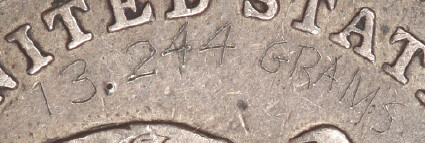
To read the earlier E-Sylum article, see: QUERY: AN ENGRAVED 1840-O HALF DOLLAR (www.coinbooks.org/esylum_v15n33a11.html)
A Life-Changing First Cent
Tom DeLorey adds:
As to receiving coins of the new year early in the year, on January 6, 1973, I was working as a cashier in Detroit, and I noticed in somebody's deposit a bright, shiny 1973 cent. I replaced it with another, and that night noticed that Frank Gasparro had doubled the size of his initials on the reverse. I stuck it in an envelope and mailed it off to Coin World with this observation, thinking it might merit one paragraph in Collectors Clearinghouse, to which I had already submitted an application for employment.
It arrived in the proverbial slow news week, and was splashed across the front page. Later that year when CW was looking for a proofreader with numismatic experience, Margo went through the applications on file and remembered my name from the 1973 cent story. I got the job, and next year transferred to Clearinghouse working for Ed Fleischmann. Later I followed Ed to ANACS, and the rest of my numismatic career followed from that, all because I got a 1973 cent in change on January 6th!
To read the earlier E-Sylum article, see: NOTES FROM E-SYLUM READERS: AUGUST 5, 2012: First Coins of the New Year (www.coinbooks.org/esylum_v15n33a08.html)
Love Your Numismatic Librarian
Dan Freidus writes:
Have you taken advantage of the great numismatic libraries of the American Numismatic Association or American Numismatic Society? If so, I'd encourage you to nominate a librarian for the American Library Association's 2012 "I love my librarian" award. (For the purposes of these awards, these libraries would be considered "public libraries".)
Anyone who does numismatic research would have a much tougher time without these libraries and their librarians (Elizabeth Hahn at ANS & RyAnn Scott at ANA). Whether you have visited the library in person or gotten help via email or phone or only used online resources, you've been helped by their work. Let's show them our appreciation. Nominations are open until September 12.
To nominate a librarian, see: atyourlibrary.org/ilovemylibrarian/nominate-your-public-librarian
Another Noah's Ark Coin
Alan Luedeking writes:
Here's another Noah's Ark coin: 1/2 Piastra AN VII (1697/98), Rome. Muntoni 28
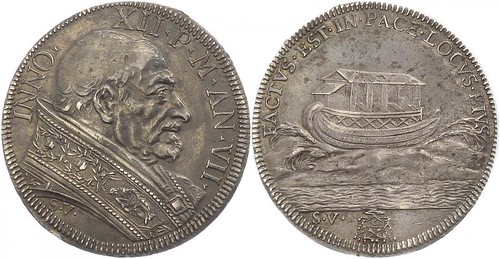
To read the earlier E-Sylum article, see: QUIZ ANSWER: NOAH'S ARK ON COINS (www.coinbooks.org/esylum_v15n34a08.html)
On the Origin of Specie
MONEY is perhaps the most basic building-block in economics. It helps states collect taxes to fund public goods. It allows producers to specialise and reap gains from trade. It is clear what it does, but its origins are a mystery. Some argue that money has its roots in the power of the state. Others claim the origin of money is a purely private matter: it would exist even if governments did not. This debate is long-running but it informs some of the most pressing monetary questions of today.
Money fulfils three main functions. First, it must be a medium of exchange, easily traded for goods and services. Second, it must be a store of value, so that it can be saved and used for consumption in the future. Third, it must be a unit of account, a useful measuring-stick. Lots of things can do these jobs. Tea, salt and cattle have all been used as money. In Britain’s prisons, inmates currently favour shower-gel capsules or rosary beads.
The use of money stretches back millennia. Electrum, an alloy of gold and silver, was used to make coins in Lydia (now western Turkey) in around 650BC. The first paper money circulated in China in around 1000AD. The Aztecs used cocoa beans as cash until the 12th century. The puzzle is how people agreed what to use.
To read the complete article, see: On the origin of specie (www.economist.com/node/21560554)
GEORGE CLAPP'S COST CODE: MENDACIOUS
Jim Neiswinter writes:
I was at the American Numismatic Society on Friday looking through files of George Clapp letters from the mid-1940s. I found Clapp's Cost code among the letters. Could it have been inspired by Max Mehl?

19TH CENTURY COUNTERFEIT DETECTION & PREVENTION LITERATURE
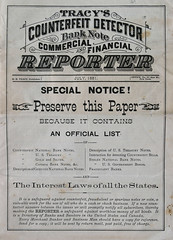 While working on last week's E-Sylum I watched a video of Michael Sullivan's presentation on 19th Century Counterfeit Detection & Prevention Literature, given at the 2012 Memphis Paper Money Show. It's a well-organized and illustrated talk, which was accompanied by a multi-case exhibit of examples from Michael's extensive numismatic library. The exhibit won the Mike Crabb award given by the Memphis paper Money Club.
While working on last week's E-Sylum I watched a video of Michael Sullivan's presentation on 19th Century Counterfeit Detection & Prevention Literature, given at the 2012 Memphis Paper Money Show. It's a well-organized and illustrated talk, which was accompanied by a multi-case exhibit of examples from Michael's extensive numismatic library. The exhibit won the Mike Crabb award given by the Memphis paper Money Club.
The video was produced by David Lisot and is available thru the www.cointelevision.com site. Many thanks to Michael for sending it and providing the accompanying images for The E-Sylum. At right is an 1881 Tracy's Counterfeit Detector.
The below receipt indicates the existence of a PRESBURY & CO. Counterfeit Detector, but according to Michael Sullivan he's been unable to locate of identify an extant example in over twenty years of collecting.
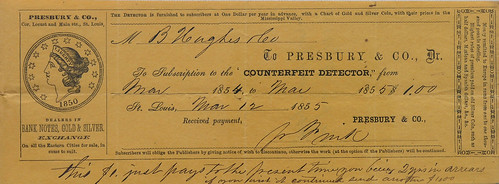
An 1858 Presbury Bank Note Reporter receipt
Here are an 1857 Willis Bank Note List and an 1864 National Bank Note Reporter from Pittsburg, PA:

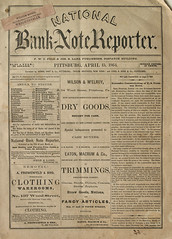
QUERY: THE LOST ARCHIVES OF AUGUSTUS HEATON SOUGHT
Edward Carmody writes:
I am searching for the "lost archives" of Augustus Heaton for his late 19th century book on Mint Marks. I was hoping for a lead to a living relative, but I've had nothing but dead ends. The family tree seems to end with John G. Heaton (b. 1910/d 1970).
I have since tried to guess where Augustus Heaton may have donated his papers to ensure their survival (The Smithsonian, The U.S. Senate Historical Collection, the ANA and ANS and finally the Pennsylvania Academy of Fine Arts, where he went to school. This approach has also come up empty.
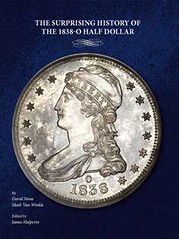 I am hoping to find the original handwritten presentation note from Rufus Tyler ( Chief Coiner for the New Orleans Branch Mint) to Alexander Bache. This note was wrapped around the only surviving 1838-O Half Dollar that was actually produced in New Orleans. The 2012 study "The Surprising History of the 1838-O Half Dollar" by David Stone and Mark Van Winkle indicates that 10 coins were produced in Philadelphia, of which 9 survive ...and Tyler produced an additional 10 in New Orleans, of which only one survives ( the specimen that was presented to Alexander Bache.).
I am hoping to find the original handwritten presentation note from Rufus Tyler ( Chief Coiner for the New Orleans Branch Mint) to Alexander Bache. This note was wrapped around the only surviving 1838-O Half Dollar that was actually produced in New Orleans. The 2012 study "The Surprising History of the 1838-O Half Dollar" by David Stone and Mark Van Winkle indicates that 10 coins were produced in Philadelphia, of which 9 survive ...and Tyler produced an additional 10 in New Orleans, of which only one survives ( the specimen that was presented to Alexander Bache.).
The note was published in the July 1894 issue of The Numismatist, and the note and coin were sold to Augustus Heaton. It has not been seen since that date. I believe that Heaton kept the note with his background material for his book on Mint Marks (in which the 1838-O had significant mention), rather than with the coin. He knew the historical importance of the note and would have taken steps to preserve it.
Heaton's coin collection was sold in its entirety after his death (1930) and it passed on to Col. Green, but the Rufus Tyler note was not included. My hope is to find the archives, find the note, and reunite it with the coin.
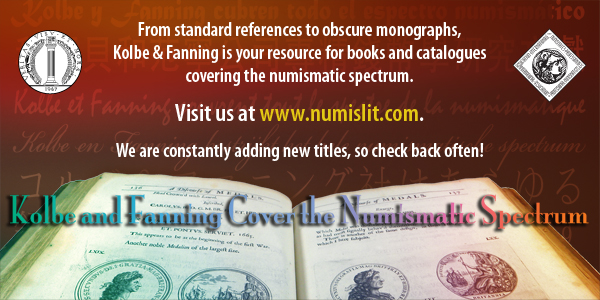
ERIC NEWMAN: A NATIONAL TREASURE
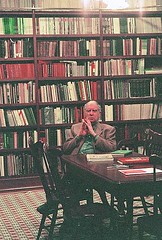 The topics covered in my last three columns — The Fantastic 1804 Dollar; the rare bound proof edition of that great book; and The Secret of the Good Samaritan Shilling — have one common factor: they were written by Eric P. Newman, either by himself or in partnership with others.
The topics covered in my last three columns — The Fantastic 1804 Dollar; the rare bound proof edition of that great book; and The Secret of the Good Samaritan Shilling — have one common factor: they were written by Eric P. Newman, either by himself or in partnership with others.
Eric is a living national treasure with a lifetime of jaw-dropping hobby achievements. He once owned all five 1913 Liberty Head 5-cent coins simultaneously, and he still owns the unique “George Washington President” pattern in gold that was probably Washington’s “pocket piece.”
But Eric would qualify for living national treasure status solely for his literary accomplishments. Any numismatist would be ecstatic to win a single Heath Literary Award for best article published in The Numismatist; Eric has won a whopping 15! Any numismatist would be proud to build a strong research library; Eric’s is so comprehensive that it resides at Washington University in St. Louis, along with his superb coin collection, as part of the Newman Money Museum. Any numismatist would be pleased to teach an American Numismatic Society Summer Seminar; Eric has a Summer Seminar series named in his honor. Any numismatist would be thrilled to write a single book; Eric has written a dozen.
Writing these masterpieces has not left Eric too busy or arrogant to help young scholars. In 1988, when another towering figure in numismatic literature, Q. David Bowers, published my first numismatic book, he asked Eric to write its foreword. The subject was Pierre Eugene Du Simitiere, who immigrated to the American colonies in 1763, eventually settling in Philadelphia, where he became one of the nation’s pioneering coin collectors.
Eric had been the first to call the numismatic world’s attention to Du Simitiere’s collecting activities, in The Early Paper Money of America, but he nonetheless wrote a generous foreword for my book, and also corrected some other errors before it was published.
JOEL J. OROSZ is a charter member of the Numismatic Bibliomania Society and co-author of The Secret History of the First U.S. Mint. He can be reached at Joeljorosz@gmail.com.
To read the complete article, see: A 'living national treasure' - Hats off to Eric Newman (www.coinworld.com/articles/a-living-national-treasure/)
ARTICLE HIGHLIGHTS BANKNOTE EXPERT BARNABY FAULL OF SPINK
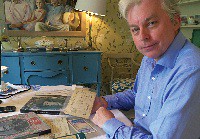 The other thing Barnaby's been collecting during his time at Spink is some fantastic stories. There was the chap who came into the office with a whole bundle of hundred pound notes from the 1930s which, when they were printed, would have each bought a couple of terraced houses in Battersea. "He'd found about forty of these notes in a safe in Jersey and left them with us to sell. Within the bundle there were about eight thousand-pound notes he hadn't noticed. Each of those would have bought you a house in Belgravia in the '30s. A thousand pound note is now worth about twenty five thousand pounds at auction; a house in Belgravia... well, I dread to think!"
The other thing Barnaby's been collecting during his time at Spink is some fantastic stories. There was the chap who came into the office with a whole bundle of hundred pound notes from the 1930s which, when they were printed, would have each bought a couple of terraced houses in Battersea. "He'd found about forty of these notes in a safe in Jersey and left them with us to sell. Within the bundle there were about eight thousand-pound notes he hadn't noticed. Each of those would have bought you a house in Belgravia in the '30s. A thousand pound note is now worth about twenty five thousand pounds at auction; a house in Belgravia... well, I dread to think!"
There was the time Barnaby had to buy (for a period of 12 hours) the entire contents of the lockable duty free cupboard on a grounded aeroplane in order to leave a client's collection in a safe place overnight when he was required to disembark for the night in Bombay but couldn't take the collection with him through customs.
Then there was the man who bought a piece of antique furniture in the back of which he found about five banknotes which went on to sell for two hundred and fifty thousand pounds. And the elderly gentleman who brought in an album of Zanzibar notes printed by a company called Waterlow whose archive had been destroyed by fire.
"This chap came in with a collection of notes which he'd been given when he was a boy; presumably one of his relatives was connected with the production of the notes. It was an extraordinary collection which he decided to sell and give the money to charity. We catalogued and auctioned it for him and it went for about a hundred and seventy thousand pounds; he was sitting in the room as I did the auction, completely agog," enthuses Barnaby. "The whole thing was great fun. That's the human side of things."
To read the complete article, see: National Treasure: Barnaby Faull (www.spink.com/research-articles/national-treasure-barnaby-faull.aspx)
WAYNE'S NUMISMATIC DIARY: AUGUST 19, 2012
 Tuesday August 14th was the meeting night of my monthly Northern Virginia numismatic social group, Nummis Nova. Julian Leidman was our host, and we met at Jerry's Seafood in Lanham, MD. Their trademark dish is the Crab Bomb (check it out at crabbomb.com/). I ordered it, and it was da bomb...
Tuesday August 14th was the meeting night of my monthly Northern Virginia numismatic social group, Nummis Nova. Julian Leidman was our host, and we met at Jerry's Seafood in Lanham, MD. Their trademark dish is the Crab Bomb (check it out at crabbomb.com/). I ordered it, and it was da bomb...
I arrived nearly an hour early, but I wasn't the first one there - Howard Daniel was already at a table enjoying an appetizer. I sat down and we had a great conversation. When the waitress asked Howard how he was doing, he said "Terrible .... I'm still married..." He was kidding of course, and continued to kid the staff to death throughout the evening. When asked how his dinner was, he said "I need a doctor..."
Howard gave me a surplus copy of the catalog for the upcoming September Bonham's sale in Los Angeles. Coincidently, the Kellogg & Humbert gold bar illustrated on the cover is discussed elsewhere in this E-Sylum issue.
As others began to arrive the restaurant staff set us up in another area, building up a long table. Howard and I were at the far end, and others filled the remaining seats on arrival. Other attendees were Chris Neuzil, Dave Schenkman, Eric Schena, Gene Brandenburg, Joe Levine, Jon Radel, Julian Leidman, Roger Burdette, Tom Kays and guests Andy Singer and John Huffman. This was the first occasion Andy's been able to join us.
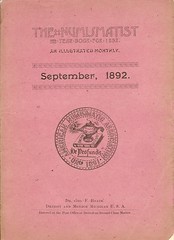 Because of the recent convention our theme for the evening was new acquisitions and ANA medals and memorabilia. I brought a couple of ephemera binders which included some early issues of The Numismatist and early ANA publications such as Charles Tatman's The Virginia Coinage and Frederic Haskins' Everybody's Coin Book. Here are some images.
Because of the recent convention our theme for the evening was new acquisitions and ANA medals and memorabilia. I brought a couple of ephemera binders which included some early issues of The Numismatist and early ANA publications such as Charles Tatman's The Virginia Coinage and Frederic Haskins' Everybody's Coin Book. Here are some images.
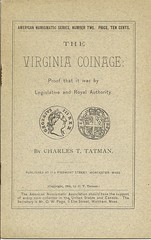
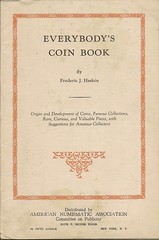
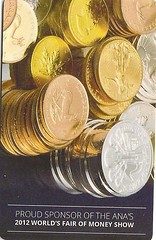 In the way of modern ANA convention ephemera, Dave Schenman showed off his room key card, which has advertising from AMPEX.
In the way of modern ANA convention ephemera, Dave Schenman showed off his room key card, which has advertising from AMPEX.
Some folks brought along their ANA membership anniversary medals. A couple of us have been members for 25+ years. Dave Schenkman showed off his 50-year member medal. He also had a medal awarded to him by the Token and Medal Society (TAMS). It was an award he'd created himself many years ago to honor authors in the token and medal field - the David Schenkman Literary Award. Now the organization awarded it to HIM - he'd won his own medal!


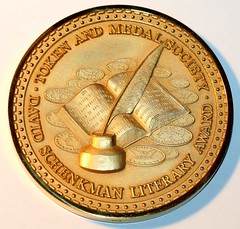

A lot of other show-and-tell items were passed around the table. Tom Kays passed around a box of small English silver coins, a dug lot purchased from a metal detectorist, and representing 500 years of British history. Eric Schena brought some rare Virginia tokens.
Eric Schena writes:
Since the theme was new acquisitions, I brought some newly found tokens from Nuttsville in Lancaster Co. on Virginia's Northern Neck. I was lucky to get a set of six tokens, only two of which actually state the town name (the two illustrated here). These supposedly came from a descendant of the original merchant. W. T. Richardson appears on the 1920 Bradstreet as a dealer in general merchandise. I love this sort of thing since it demonstrates that new discoveries can happen with relative frequency in the field of local token collecting.
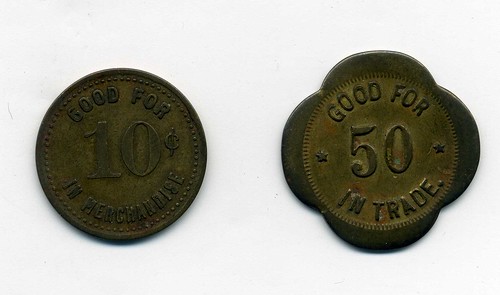
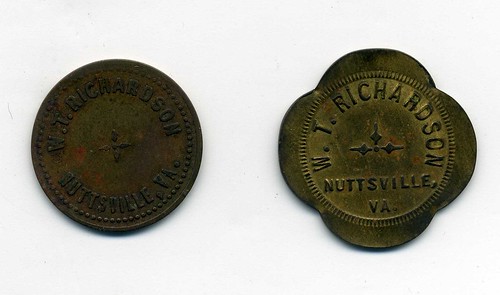
Sometimes I feel like I'm living in Nuttsville...
Dave Schenkman passed around this new acquisition from the ANA - a Third Avenue Rail Road transportation token (NY630-O):
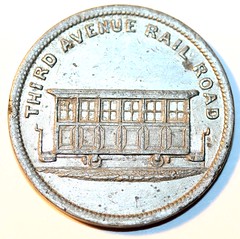
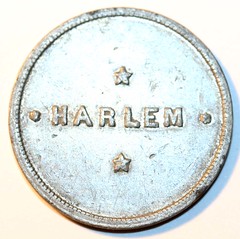
 At the Philadelphia ANA convention Howard had been given the task of delivering my NLG award plaque. He recruited fellow NLG member Joe Levine to make the presentation, and Howard captured the event with a photo (see the above article in this issue).
At the Philadelphia ANA convention Howard had been given the task of delivering my NLG award plaque. He recruited fellow NLG member Joe Levine to make the presentation, and Howard captured the event with a photo (see the above article in this issue).
As for me, I proudly passed around my newest Carnegie Hero medal, this one from France. The overseas Hero Funds are completely separate from the U.S. Carnegie Hero Fund Commission, with separate management, funding, and medals. This is a nice one.
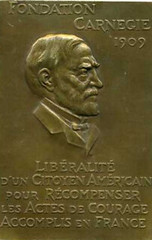
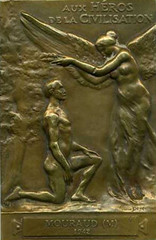
My other exhibit was delivered to me by Joe Levine - it's the Anna Hyatt Huntington elephant medal I purchased from his fixed price list.
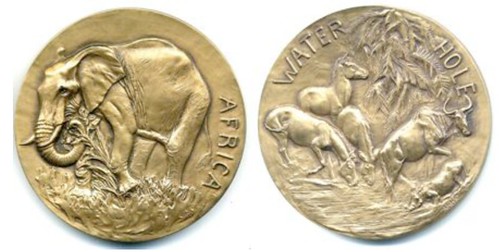
 Joe also brought a couple books he thought I'd be interested in. I made him and offer and took them home. One was a copy of Prime, and the other was a nearly pristine copy of the 1914 ANS Colonial Coin exhibit catalog. They came from the estate of Harvey Elfenstein. Joe will be offering Elfenstein's vast collection of American Numismatic Society medals and an extensive collection of American Numismatic Association Badges and medals. The ANS collection includes the very rare "TO GUS FOR VALOR" medal, one of only three struck. Below are some images Joe kindly passed along. Did any of our readers know Elfenstein?
Joe also brought a couple books he thought I'd be interested in. I made him and offer and took them home. One was a copy of Prime, and the other was a nearly pristine copy of the 1914 ANS Colonial Coin exhibit catalog. They came from the estate of Harvey Elfenstein. Joe will be offering Elfenstein's vast collection of American Numismatic Society medals and an extensive collection of American Numismatic Association Badges and medals. The ANS collection includes the very rare "TO GUS FOR VALOR" medal, one of only three struck. Below are some images Joe kindly passed along. Did any of our readers know Elfenstein?
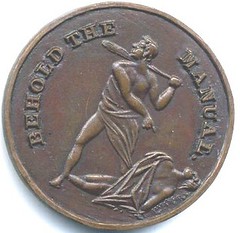
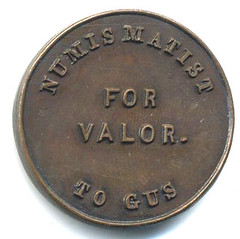
QUICK QUIZ: So who's Gus? And what was the occasion for the awarding of this medal?
Several folks hung around after dinner and it was then I had a nice conversation with Roger Burdette and Chris Neuzil, who had spoken to Bob Julian at the ANA convention about research for Bob's upcoming book on the early days of the US. Mint. But by about ten after nine I decided to hit the road. It was time to avoid the fate of the getting-in-late guy from Tuesday's Good Clean Funnies joke:
The other night I was invited out for a night with the guys. I told my wife that I would be home by midnight... "I promise!"
Well, the hours passed quickly and the beer was going down way too easy. At 3 am, drunk as a skunk, I headed for home. Just as I got in the door, the cuckoo clock in the hall started up and cuckooed three times.
Quickly, I realized she'd probably wake up, so I cuckooed another 9 times. I was really proud of myself for having such a rapid, witty solution, even when smashed, to escape a possible conflict.
The next morning my wife asked me what time I got in, and I told her 12 o'clock. She didn't seem disturbed at all. Got away with that one, I thought!
Then she told me we needed a new cuckoo clock. When I asked her why she said, "Well, last night it cuckooed 3 times, then said, 'Oh crap,' cuckooed 4 more times, cleared its throat, cuckooed another 3 times, giggled, cuckooed twice more, and then farted."
To read the complete article, see: Getting In Late (www.gcfl.net/archive.php?funny=6429)
ABE KOSOFF INDUCTED INTO THE DEALERS HALL OF FAME
Harvey Stack writes:
I was at the ANA for only 3 days, last Wednesday, Thursday, and Friday. I was indeed kept busy greeting friends and working for my consignors at the various sessions of our Stacks Bowers Auction.
I wanted to attend the NBS meetings but one conflicted with a presentation I made to induct Abe Kosoff into the DEALERS HALL OF FAME. That was a long luncheon meeting that conflicted with NBS that day.
Since E-Sylum readers might like to see what I said, I enclose a copy of my presentation remarks, as one of the previous dealers who was inducted last year to the Hall of Fame.
I am sure many of our members who could not be every where all the time would like to know of A. Kosoff's induction to the RARE COIN DEALERS HALL OF FAME.
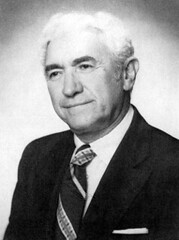 I have the distinct pleasure of announcing that
Abraham Kosoff, (aka A. Kosoff and Abe to
his friends) has be nominated to the Rare
Coin Dealers Hall of Fame.
I have the distinct pleasure of announcing that
Abraham Kosoff, (aka A. Kosoff and Abe to
his friends) has be nominated to the Rare
Coin Dealers Hall of Fame.
Abe entered the numismatic profession in 1930 at the age of 17 years, (two years after I was born) and began his venture through the hobby as the depression of the 1930's took hold.
His earliest contacts sold him gold coins on which he could sell to dealers and collectors for literally a few cents profit, and he also dealt with buying and selling gold scrap and artifact which fluctuated on a daily basis, and he was able to make a living .
He was an active member of the Brooklyn Coin Club which had in its membership some of the great dealers and collectors of the 1930's. These club members met once a month, had great learned discussions, showed their latest as well as cherished coins from their collections, and provided the unbelievable and rare knowledge that the collectors and dealers had during this period and shared it with the new members as well as others who were at all their meetings. The same group met with others at the growing New York Coin Club who met monthly and attracted numismatists, not only from New York but from New Jersey, Long Island, The Bronx and Westchester. as well as Connecticut.
The coins seen and knowledge acquired at these meetings was endless, and the personal knowledge obtained was priceless.
Abe Kosoff developed in this wonderful environment, and by 1937 hung out his shingle "A. Kosoff, Professional Numismatist"
In the early 1940's he met F.C.C. Boyd and their friendship led to the sale in the mid 1940's of the World's Greatest Collection,, which Abe sold on behalf of Boyd. After the second world war he partnered with Abner Kreisberg, and occasionally with Hans M.F. Schulman.
Is interests included a great interest in the growth of the Hobby and to make the dealer receive more respect from the American Numismatic Association. The professional collectors felt that the dealers were not well informed and Abe with his writings and cataloging tried to prove that the dealer was important part of the hobby.
In 1953 he and Sol Kaplan called a meeting of the major dealers who were available in New York after a coin show, met on my Uncle Joe's lawn in Queens, and set forth the formation of the what became in 1955 the PNG (the Professional Numismatic Guild), and Abe was its first president. He continued his efforts to elevate the status of the Professional dealer in the eyes of the collector.
At the same time in 1952 he led a delegation of dealers and collectors to Cairo to bid on the coins of King Farouk. Among those who went with him was Sol Kaplan, Hans M.F. Schulman, John J. Pittman, Gaston DiBello to mention some, together with bids in hand representing a number of well known collectors.
During the 1950's he conducted a number of important sales, and then in the 1970's he worked with Ken Bressett on establishing a newer form of grading known as the "Sheldon Numerical System" modeled after the one conceived by Dr. William Sheldon for "Early U.S. Large Cents". At a meeting in Colorado Springs at ANA Headquarters in 1973, a large group of professional dealers and collectors passed a resolution to adopt Numerical Grading (with reservations)
Kosoff meanwhile acted as representative and dealer to many collector, and conducted several sales during the 1950's to late 1970's.He during this period help re-write the Judd Book on Patterns, which is still used till this very day. Early in life he developed shocking white hair, and as he was always dealing an negotiating he acquired the nick name "the Silver Fox", which he accepted, but since he always admired the way B. Max Mehl developed his way in the business mostly before Abe obtained his status he always hoped to acquire the name "Dean of Numismatic" as he was called by many for his great knowledge, way of dealing and working towards elevation of the Dealers in numismatics.
During his lifetime he continued to advocate the value of the Professional dealer, and tried to promote the hobby by lecturing and writing about coins and his experiences and therefore made a major contribution to the growth and prestige the Numismatic Hobby and Profession enjoys today.
It is with great honor and pleasure I nominate Abe Kosoff to the Numismatic Dealers Hall of Fame.
To read more about the PCGS Coin Dealer Hall of Fame, see: http://www.pcgs.com/pcgscoinfacts/CoinDealerHOF.html
THE BOOK BAZARRE
QUERY: WORLD WAR I VERDUN MEDAL INFORMATION SOUGHT
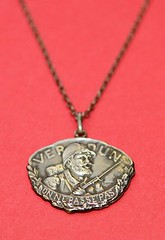 Mary Alice Altorfer was a little strapped for cash so she decided to turn to eBay for a little quick dough.
Mary Alice Altorfer was a little strapped for cash so she decided to turn to eBay for a little quick dough.
The avid antiquer, who also works part-time for the New Braunfels Herald-Zeitung, put up for auction an old trinket she found years ago at a yard sale in North Carolina and for which she paid a slight pittance. Little did she know she had in her clutches a valuable medal from the first World War.
To read the complete article, see:
Medal unexpected windfall for NB woman
(herald-zeitung.com/news/local_news/article_
b43945ce-e8dc-11e1-b242-0019bb2963f4.html)
MONTFORD POINT MARINES AWARDED CONGRESSIONAL GOLD MEDAL
Members of the Montford Point Marines are gathering in Washington D.C. this week to receive their long-anticipated Congressional Gold Medal.
“It’s been a long time coming,” said Norman Preston, 90, an original Montford Point Marine. “I’m proud of us; we were the pioneers of the Marine Corps and we are really being honored and respected ... We couldn’t ask for anything better.”
The Montford Point Marines were the first blacks to join the Corps after they were finally allowed to serve. The Marines trained at the segregated Montford Point, aboard what is now Camp Johnson in Jacksonville. Many were barred from entering establishments, forced to work and train harder than their white counterparts and faced discrimination and prejudice from fellow troops and outsiders.
“They treated us like a bunch of dogs,” said Paul Hagan, 84, as he prepared to board a plane Tuesday to D.C. to receive his award. “But they’re doing a good job now because they’re finally recognizing us ... I really think we rate (the Congressional Gold Medal).”
Overall 19,168 black men trained at Montford Point from 1942 to 1949. Of those, only about 400 remain, all of whom received invitations to the two-day ceremony, which will begin today, June 27.
To read the complete article, see: Montford Point Marines awarded Congressional Gold Medal (www.jdnews.com/articles/montford-105481-gold-point.html)
Gar added this text from Wikipedia:
When Franklin D. Roosevelt signed Executive Order 8802, blacks were, for the first time, permitted to join the Marine Corps. One of the first African Americans to enlist in the United States Marine Corps was Gilbert "Hashmark" Johnson, who became a drill instructor. Between 1942 and 1949, the camp at Montford Point was a recruit depot for black recruits, training 20,000 African Americans during that period.
In 1948, by Executive Order 9981, President Harry S. Truman ordered the military to integrate. In 1974, Montford Point was renamed Camp Gilbert H. Johnson in honor of the late Sergeant Major Gilbert H. "Hashmark" Johnson. A Montford Point drill instructor, he served during World War II and the Korean War. Camp Johnson became the home of the Marine Corps Combat Service Support Schools.
In 2007, a documentary entitled The Montford Point Marine Project was released, honoring the black Marines who trained at Montford Point. Montford Point, which is now known as Camp Johnson is located near Jacksonville, North Carolina and is adjacent to Marine Corps Base Camp Lejeune.
To read the complete article, see: en.wikipedia.org/wiki/Camp_Gilbert_H._Johnson
CHIANG KAI-SHEK'S ORDER OF BLUE SKY AND WHITE SUN MEDAL
 Spink announce its upcoming Collector’s Series auction in Hong Kong to be held on 24 August 2012. Leading the sale is a unique and magnificent medal “Order of Blue Sky and White Sun” awarded to Chiang Kai-shek in 1930, estimated at HK$3-5 million. It is the first time this precious medal in exceptional condition has ever appeared at auction and is expected to generate enormous interest amongst collectors.
Spink announce its upcoming Collector’s Series auction in Hong Kong to be held on 24 August 2012. Leading the sale is a unique and magnificent medal “Order of Blue Sky and White Sun” awarded to Chiang Kai-shek in 1930, estimated at HK$3-5 million. It is the first time this precious medal in exceptional condition has ever appeared at auction and is expected to generate enormous interest amongst collectors.
According to a book on this medal written by respected collector and scholar Chuk Hong Ming, the “Order of Blue Sky and White Sun” was instituted in 1929 after the Nationalist government was established in Nanking (Nanjing). It was the highest military decoration awarded to any military personnel for their distinguished achievements in defending the country against the enemy. It hence signified the supreme glory and gallantry of the awardee.
Chiang Kai-shek, then head of state of the Chinese Nationalist government and generalissimo of all Chinese Nationalist forces, was awarded this medal in 1930. According to Chuk, this was one of his most favourite medals that he often wore alongside the “Order of Brilliant Jade with Grand Cordon”, a medal presented exclusively to the head of the state.
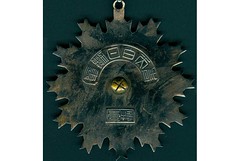 Of particular note, this medal on offer, bearing the characters “Special One” instead of the usual numbering, is unique as evidenced by the well-known photograph of Chiang Kai-shek wearing the flipped over medal revealing the characters.
Of particular note, this medal on offer, bearing the characters “Special One” instead of the usual numbering, is unique as evidenced by the well-known photograph of Chiang Kai-shek wearing the flipped over medal revealing the characters.
To read the complete article, see: A unique medal awarded to Chiang Kai-shek on offer at Spink's Hong Kong auction (artdaily.com/index.asp?int_sec=2&int_new=57095#.UCxRX92PX-s)
NEW MEDAL REPOSITORY OPENED IN WAIOURU, NEW ZEALAND
The new Medal Repository at the National Army Museum in Waiouru has opened Thursday with 10,000 war medals, all donated by the families of servicemen. A number of medals were stolen from there in 2007.
The repository was opened by Defence Minister Dr Jonathan Coleman who said there have been other changes at the museum.
He said a database will now allow visitors with family connections to find the donated medal and information about their relative.
Today's opening is a tribute to one of the country's most decorated heroes, Reginald Judson, who was awarded the Victoria Cross, the Distinguished Conduct Medal and the Military Medal between July and August 1918.
To read the complete article, see: New medal repository opened (www.radionz.co.nz/news/regional/113419/new-medal-repository-opened)
Here’s another article: New medals museum opens after thefts (www.nzherald.co.nz/nz/news/article.cfm?c_id=1&objectid=10827468)
BANK OF CANADA PURGED IMAGE OF 'ASIAN-LOOKING' WOMAN
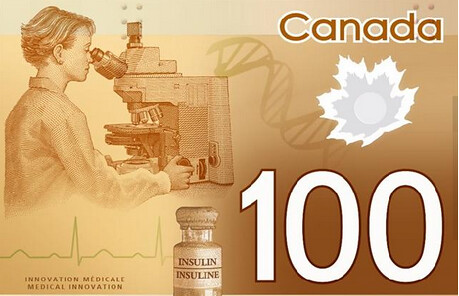
The neutral "non-Asian-looking" woman
The Bank of Canada purged the image of an Asian-looking woman from its new $100 banknotes after focus groups raised questions about her ethnicity.
The original image intended for the reverse of the plastic polymer banknotes, which began circulating last November, showed an Asian-looking woman scientist peering into a microscope.
The image, alongside a bottle of insulin, was meant to celebrate Canada's medical innovations.
But eight focus groups consulted about the proposed images for the new $5, $10, $20, $50 and $100 banknote series were especially critical of the choice of an Asian for the largest denomination.
"Some have concerns that the researcher appears to be Asian," says a 2009 report commissioned by the bank from The Strategic Counsel, obtained by The Canadian Press under the Access to Information Act.
"Some believe that it presents a stereotype of Asians excelling in technology and/or the sciences. Others feel that an Asian should not be the only ethnicity represented on the banknotes. Other ethnicities should also be shown."
A few even said the yellow-brown colour of the $100 banknote reinforced the perception the woman was Asian, and "racialized" the note.
The bank immediately ordered the image redrawn, imposing a "neutral" ethnicity for the woman scientist who, now stripped of her "Asian" features, appears on the circulating note. Her light features appear to be Caucasian.
"The original image was not designed or intended to be a person of a particular ethnic origin," bank spokesman Jeremy Harrison said in an interview, citing policy that eschews depictions of ethnic groups on banknotes.
"But obviously when we got into focus groups, there was some thought the image appeared to represent a particular ethnic group, so modifications were made." Harrison declined to provide a copy of the original image, produced by a design team led by Jorge Peral of the Canadian Bank Note Co.
Nor would he indicate what specific changes were made to the woman researcher's image to give her a so-called "neutral," non-ethnic look. He said the images were "composites" rather than depicting any specific individual.
I can't help it, but this reminds me of dialog from Woody Allen's 1966 movie, "What's Up, Tiger Lily?" Allen took a Japanese action film and re-dubbed it, completely changing the plot to make it revolve around a secret egg salad recipe. Two very Asian-looking gentlemen encounter one another when one says...
Man #1: You Chinese?
Man #2: I'm not Chinese.
Man #1: You SURE you're not Chinese?
Man #2: No, I'm NOT Chinese.
Man #1: Well, you LOOK Chinese...
Man #2: I'M NOT CHINESE!!!
-Editor
To read the complete article, see:
Bank of Canada bans image of 'Asian-looking' woman from new $100 banknotes
(www.windsorstar.com/business/Bank+Canada+bans+image+Asian
+looking+woman+from+banknotes/7108797/story.html)
THE LITHUANIAN BANK NOTE BUILDING
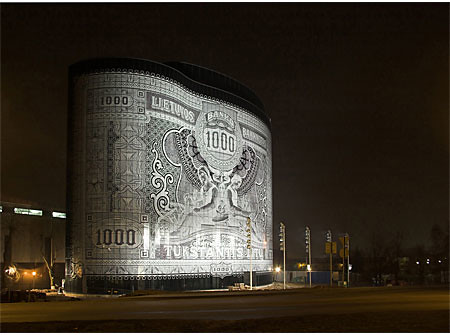
To read the complete article, see: Lithuanian bank note building (creativeroots.org/2009/04/lithuanian-bank-note-building/)
FEATURED WEB PAGE: LITHUANIAN-AMERICAN LODGE TOKENS
Speaking of Lithuania, this week's Featured Web Page is a 1981 Numismatist article by Frank Passic on the Lithuanian-American Lodge Tokens of Chicago.
The collection of Lithuanian American lodge tokens presented here was originally assembled by the late Dr. Alexander M. Rackus (1893-1965), himself an immigrant who came to Chicago. A member of the ANA, Rackus wrote several articles for the Numismatist in the 1920s and 1930s, and served as historical/numismatic curator of the Vytautas, the Great museum in Kaunas, Lithuania, 1936-1940. A listing of the Chicago lodge token appeared in the November, 1948 issue (No. 4) of the American-Lithuanian Philatelic Specialist, which Dr. Rackus published in Chicago after the war.
However, the collection mysteriously disappeared over the years and was feared lost. In September of 1979 it was discovered in a small box behind some shelves in a closet, in the archives of the Balzekas Museum of Lithuanian Culture, 4012 Archer Avenue in Chicago. In the same box were also early Lithuanian lodge tokens from Philadelphia, Pennsylvania, and Brooklyn, New York. Since that discovery, the collection has been cataloged, photographed and placed on permanent exhibit at the museum.
As the reader will discover, these small tokens display various inconsistencies, spelling errors, and poor grammar. Many of the spelling variances are due to the heavy Polish influence under which the Lithuanians tried to establish their own separate identity. Though the Lithuanian written language was being purged of Polish influences, that influence still shows up on many of these tokens.
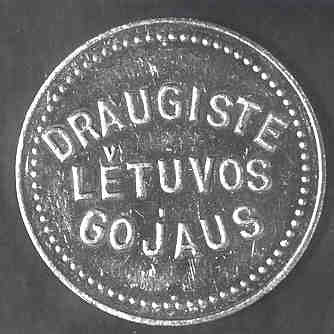
www.albionmich.com/history/
histor_notebook/S_Lodge.shtml
